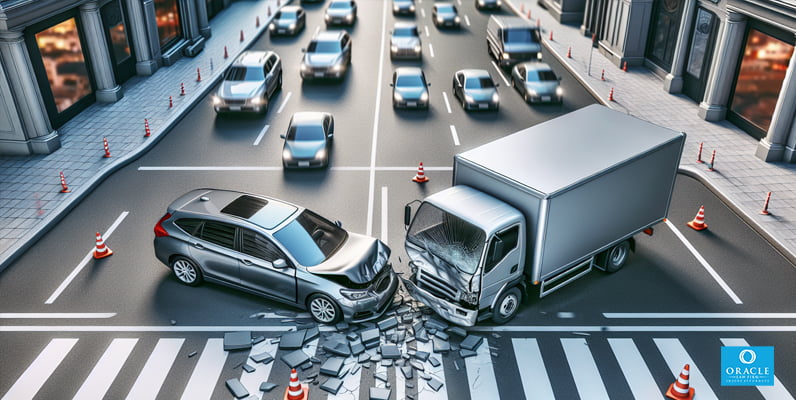Every day, the roads witness many car accidents, each with potential consequences for drivers, passengers, and pedestrians. You may wonder how many car accidents occur per day. On average, the United States experiences about 14,386 car crashes daily. This article delves into that staggering statistic to uncover the multifaceted impact of daily car accidents, explores the factors contributing to these incidents, and discusses the broader implications on safety, policy, and the economy.
Key Takeaways
- The United States averages 14,386 car accidents per day, leading to 99 fatalities and around 7,507 nonfatal injuries, highlighting an urgent need for improved road safety measures.
- More than 90% of car accidents are attributed to human errors like distracted driving, influenced driving due to alcohol and drugs, and speeding, indicating the critical importance of responsible driving behaviors.
- Safety devices like seat belts and advanced features like airbags and Electronic Stability Control (ESC) have proven effective in reducing fatalities and injuries from car accidents, underlining the significance of vehicle safety measures and correct usage.
Daily Car Accident Overview

Every day, countless drivers, passengers, and pedestrians experience the impact of car accidents. These incidents, unfortunately, are a common occurrence in our daily lives. The United States sees an average of 14,386 car accidents per day. These accidents vary in severity, from minor fender benders to fatal collisions.
Grasping these figures helps us fathom the gravity and frequency of these incidents daily.
Nationwide Daily Car Crash Statistics
The figures are quite alarming when we consider how many car accidents occur on a national scale. In the U.S., more than 6 million passenger car accidents happen every year. These accidents have a significant impact on road safety and traffic. That’s right, 6 million. This equates to an average of 14,386 car crashes per day. With such staggering car accident statistics, it’s crucial to prioritize road safety measures.
These numbers underline the problem’s magnitude and stress the need for road safety measures and responsible driving.
Fatal Car Accidents Each Day

While not every car accident is fatal, those that are leave a devastating impact. On average, 114 fatalities from car accidents occur every day in the United States. This means approximately 0.7% of all accidents in the U.S. are fatal.
Although these numbers appear small, they represent substantial life loss and serious injury, necessitating immediate action to enhance road safety.
Nonfatal Collisions: Injuries and Close Calls
While fatal accidents account for a small fraction of total accidents, nonfatal collisions are far more prevalent. These incidents result in a range of injuries, from minor scrapes and bruises to severe, life-altering conditions. Every year, between 20 and 50 million people experience nonfatal injuries as a result of car accidents. This underscores the substantial impact of car accidents on public health and safety. This averages to around 7,507 people injured in car accidents daily across the United States.
Worryingly, pedestrian and cyclist incidents have increased, contributing to the rise in nonfatal accidents.
Timing and Trends in Auto Accidents

As we probe deeper into the car accident analysis, we must consider the timing and trends. It may be surprising, but car accidents happen more frequently at certain times of the day and year. These patterns can be important for understanding traffic safety. Factors such as lighting conditions, traffic volume, and driver fatigue play a role in this pattern.
Identifying these trends is critical to comprehending and reducing the risks associated with daily driving.
Peak Times for Traffic Incidents
A close look at the data reveals interesting patterns. Both fatal and nonfatal car crashes are most likely to occur between 4 pm and 7:59 pm. This period is considered the peak time for such incidents. This could be attributed to rush hour traffic, driver fatigue after a long day, and reduced visibility during dusk.
Furthermore, late-night driving accounts for a disproportionate number of fatal crashes involving young drivers aged 16 to 17, despite it being a period when they drive less.
Seasonal and Weekly Variations
Seasonal and weekly variations also play a significant role in car accidents. For example, 17% of car crashes occur during winter, with February experiencing the fewest crash deaths and October having the most car accidents. This could be due to the challenging driving conditions during winter and increased travel during October.
Moreover, Saturdays consistently see the highest number of crashes, with nearly half of crash deaths happening on weekends.
The Human Factor: Causes Behind the Crashes
While various factors contribute to car accidents, one element stands out – the human factor. Human errors cause more than 90% of car accidents. These errors include:
- Recognition errors such as inattention and distractions
- Decision errors like speeding and aggressive driving
- Performance errors such as poor directional control
Let’s Let’ser explore these factors.
Distracted Drivers on the Road

Distracted driving is a leading cause of car accidents. Distractions include anything from using a phone and eating to adjusting the stereo. Texting while driving is particularly hazardous as it raises the likelihood of crashes by up to 23 times.
One must remember that any activity that distracts from driving can be dangerous.
Influence of Alcohol and Drugs
Alcohol and drugs have a significant influence on car accidents. In 2021, 31% of all traffic fatalities in the U.S. involved drunk drivers with a Blood Alcohol Concentration (BAC) of .08 g/dL or higher. These figures highlight the severe consequences of drinking and driving and the urgent need for continued awareness and law enforcement campaigns.
Speeding: A Persistent Problem
Speeding is another major factor contributing to car accidents. It has been a contributing factor in approximately one-third of all motor vehicle fatalities for over two decades. Speeding not only increases the risk of accidents but also makes the accidents that do occur more severe.
It’s particularly concerning among young drivers, who are most prone to speeding-related accidents.
Vehicle Types and Accident Rates
The type of vehicle involved can significantly impact the accident rates and the severity of these incidents. Whether you’re driving a passenger car, a commercial vehicle, or a motorcycle, understanding these accident rates can shed light on the risks associated with each vehicle type.
Passenger Cars vs. Commercial Vehicles

Passenger cars are involved in more accidents than commercial vehicles, but the latter tends to be more severe due to the larger size and mass of the vehicles involved.
Despite having a lower overall accident rate, accidents involving commercial vehicles often result in more severe outcomes, including higher incidences of fatalities and serious injuries in single-vehicle crashes.
Motorcycle Mishaps
Motorcycles, due to their nature, pose unique risks. Although they only make up 3% of all registered vehicles in the U.S., they accounted for 14% of all traffic fatalities and 17% of occupant fatalities in 2021. This disproportionality highlights the inherent risks associated with motorcycles and underscores the need for stringent safety measures for motorcyclists, especially considering the alarming rate of motor vehicle deaths.
Protective Measures: Seat Belts and Safety Devices
While it’s vital to understand the risks, acknowledging the protective measures that can alleviate them is equally important. Seat belts and advanced safety features are pivotal in reducing fatalities and injuries in car accidents.
Seat Belt Usage Statistics
Seat belts have been cited as one of the most effective ways of reducing fatalities in car accidents. Seat belts have saved an estimated 374,196 lives from 1975 to 2017; however, where there’s room for improvement, as nearly half of the passengers who perished in motor vehicle crashes in 2019 were not wearing seat belts at the time of the collision.
Impact of Advanced Safety Features
In addition to seat belts, advanced safety features such as airbags and Electronic Stability Control (ESC) significantly improve vehicle safety and reduce crash rates. ESC, in particular, has been proven to reduce single-vehicle crash rates by 30-50% for cars and 50-70% for SUVs. These features, when used correctly, can save countless lives.
Age and Demographics: Who’s Who’s the Wheel?
Age and demographics have a significant influence on car accidents. Young drivers, particularly those between 16 and 20 years old, have the highest fatal crash involvement rates, while senior drivers face challenges such as declining reaction times and impaired vision.
Comprehending these demographic trends can assist in informing targeted safety measures.
Young Drivers and Accident Propensity
Young drivers, especially those aged 15 to 20, are the most likely demographic to be speeding and involved in fatal crashes. This trend can be attributed to inexperience and risky driving behaviors.
Hence, programs like Graduated Driver Licensing (GDL) are crucial in phasing in full driving privileges for young drivers.
Senior Drivers and Safety Concerns
Senior drivers, although experienced, face their own set of challenges. With age, drivers often experience declining mental reaction times, reduced situational awareness, and weaker motor controls. These factors can exacerbate the difficulty of driving, especially under challenging conditions, leading to increased fatal crash involvement among seniors.
Financial Toll: The Cost of Car Accidents
Car accidents not only result in car accident injuries and emotional trauma, but they also take a considerable financial toll. The economic blow from car accidents is staggering, entailing direct costs like repairs and medical bills and extending to broader economic losses nationally and globally.
Direct Costs from Daily Accidents
The direct costs of daily accidents can be pretty substantial. Repairs from minor scratches to severe damage, like frame damage, can range from $150 to $30,000. These costs can significantly impact an individual’s situation and highlight the importance of safe driving practices and comprehensive insurance coverage.
Broader Economic Effects
The economic implications of car accidents extend far beyond direct costs. Factors such as increased insurance premiums and rental car expenses, while the vehicle is under repair, contribute to the broader economic effects. An at-fault accident can lead to an average premium increase of 42% for complete coverage and 43% for minimum coverage insurance.
Summary
Navigating the complex landscape of car accidents can be daunting. However, understanding the daily driving dangers we face, the timing and trends in auto accidents, the human factor behind the crashes, the impact of vehicle types, protective measures, and demographics can empower us to make safer decisions on the road. Indeed, each journey on the road is a shared responsibility, and every effort we make towards safer driving can save a life.
Frequently Asked Questions
What is the average number of accidents per day?
On average, there are about 19,937 car accidents per day in the U.S. This makes car accidents a significant cause of injury and death in the country.
What day has the most car accidents?
The day with the most car accidents is Saturday, with fatal crashes more frequent on weekends and nonfatal crashes peaking on Fridays. So, be extra cautious driving on weekends.
How many auto deaths in the U.S. each year?
Each year, there are nearly 43,000 fatal crashes in the U.S., with an overall deadly car crash rate of less than 1%. Jan 16, 2024.
What state has the most car accidents?
Texas has the most car accidents, with 4,068 fatal car accidents, followed by California with 3,983 fatal car accidents. Stay safe on the roads.
How many accidents happen at night?
Nearly 29% of the 5.25 million car accidents 2020 occurred after dark.






